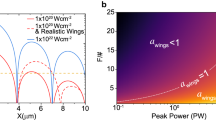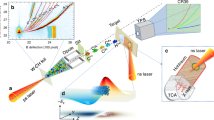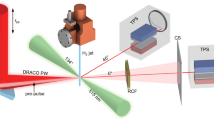Abstract
The past few years have seen remarkable progress in the development of laser-based particle accelerators. The ability to produce ultrabright beams of multi-megaelectronvolt protons routinely has many potential uses from engineering to medicine, but for this potential to be realized substantial improvements in the performances of these devices must be made. Here we show that in the laser-driven accelerator that has been demonstrated experimentally to produce the highest energy protons, scaling laws derived from fluid models and supported by numerical simulations can be used to accurately describe the acceleration of proton beams for a large range of laser and target parameters. This enables us to evaluate the laser parameters needed to produce high-energy and high-quality proton beams of interest for radiography of dense objects or proton therapy of deep-seated tumours.
This is a preview of subscription content, access via your institution
Access options
Subscribe to this journal
Receive 12 print issues and online access
$209.00 per year
only $17.42 per issue
Buy this article
- Purchase on Springer Link
- Instant access to full article PDF
Prices may be subject to local taxes which are calculated during checkout






Similar content being viewed by others
References
Clark, E. et al. Measurements of energetic proton transport through magnetized plasma from intense laser interactions with solids. Phys. Rev. Lett. 84, 670–673 (2000).
Snavely, R. A. et al. Intense high-energy proton beams from Petawatt-laser irradiation of solids. Phys. Rev. Lett. 85, 2945–2948 (2000).
Hatchett, S. et al. Electron, photon, and ion beams from the relativistic interaction of Petawatt laser pulses with solid targets. Phys. Plasmas 7, 2076–2079 (2000).
Gitomer, S. J. et al. Fast ions and hot electrons in the laser-plasma interaction. Phys. Fluids 29, 2679–2688 (1986).
Cowan, T. et al. Ultralow emittance, multi-MeV proton beams from a laser virtual-cathode plasma accelerator. Phys. Rev. Lett. 92, 204801 (2004).
Borghesi, M. et al. Multi-MeV proton source investigations in ultraintense laser-foil interactions. Phys. Rev. Lett. 92, 055003 (2004).
Fuchs, J. et al. Spatial uniformity of laser-accelerated ultrahigh-current MeV electron propagation in metals and insulators. Phys. Rev. Lett. 91, 255002 (2003).
Borghesi, M. et al. Electric field detection in laser-plasma interaction experiments via the proton imaging technique. Phys. Plasmas 9, 2214 (2002).
Patel, P. et al. Isochoric heating of solid-density matter with an ultrafast proton beam. Phys. Rev. Lett. 91, 125004 (2003).
Bulanov, S. V. et al. Oncological hadrontherapy with laser ion accelerators. Phys. Lett. A 299, 240–247 (2002).
Fourkal, E. et al. Particle in cell simulation of laser-accelerated proton beams for radiation therapy. Med. Phys. 29, 2788–2798 (2002).
Malka, V. et al. Practicability of protontherapy using compact laser systems. Med. Phys. 31, 1587–1592 (2004).
Ledingham, K., McKenna, P. & Singhal, R. Applications for nuclear phenomena generated by ultra-intense lasers. Science 300, 1107–1111 (2003).
Ledingham, K. et al. High power laser production of short-lived isotopes for positron emission tomography. J. Phys. D 37, 2341–2345 (2004).
McKenna, P. et al. Characterization of multiterawatt laser–solid interactions for proton acceleration. Rev. Sci. Instrum. 73, 4176–4184 (2002).
Zepf, M. et al. Fast particle generation and energy transport in laser-solid interactions. Phys. Plasmas 8, 2323–2330 (2001).
Spencer, I. et al. Laser generation of proton beams for the production of short-lived positron emission radioisotopes. Nucl. Instrum. Methods Phys. Res. B 183, 449–458 (2001).
Spencer, I. et al. Experimental study of proton emission from 60-fs, 200-mJ high-repetition-rate tabletop-laser pulses interacting with solid targets. Phys. Rev. E 67, 046402 (2003).
Oishi, Y. et al. Dependence on laser intensity and pulse duration in proton acceleration by irradiation of ultrashort laser pulses on a Cu foil target. Phys. Plasmas 12, 073102 (2005).
Mackinnon, A. et al. Enhancement of proton acceleration by hot-electron recirculation in thin foils irradiated by ultraintense laser pulses. Phys. Rev. Lett. 88, 215006 (2002).
Kaluza, M. et al. Influence of the laser prepulse on proton acceleration in thin-foil experiments. Phys. Rev. Lett. 93, 045003 (2004).
Hegelich, M. et al. MeV ion jets from short-pulse-laser interaction with thin foils. Phys. Rev. Lett. 89, 085002 (2002).
Allen, M. et al. Direct experimental evidence of back-surface ion acceleration from laser-irradiated gold foils. Phys. Rev. Lett. 93, 265004 (2004).
Fuchs, J. et al. Comparison of laser ion acceleration from the front and rear surfaces of thin foils. Phys. Rev. Lett. 94, 045004 (2005).
Silva, L. O. et al. Proton shock acceleration in laser-plasma interactions. Phys. Rev. Lett. 92, 015002 (2004).
D’Humières, E., Lefebvre, E., Gremillet, L. & Malka, V. Proton acceleration mechanisms in high-intensity laser interaction with thin foils. Phys. Plasmas 12, 062704 (2005).
Esirkepov, T., Borghesi, M., Bulanov, S., Mourou, G. & Tajima, T. Highly efficient relativistic-ion generation in the laser-piston regime. Phys. Rev. Lett. 92, 175003 (2004).
Mora, P. Plasma expansion into a vacuum. Phys. Rev. Lett. 90, 185002 (2003).
Gurevich, A. V., Pariiskaya, L. V. & Pitaevskii, L. P. Self-similar motion of rarefied plasma. Sov. Phys. JETP 22, 449 (1966).
Wilks, S. C. et al. Absorption of ultra-intense laser pulses. Phys. Rev. Lett. 69, 1383–1386 (1992).
Malka, G. & Miquel, J. L. Experimental confirmation of ponderomotive-force electrons produced by an ultrarelativistic laser pulse on a solid target. Phys. Rev. Lett. 77, 75–78 (1996).
Key, M. et al. Hot electron production and heating by hot electrons in fast ignitor research. Phys. Plasmas 5, 1966–1972 (1998).
Feurer, T. et al. Onset of diffuse reflectivity and fast electron flux inhibition in 528-nm-laser–solid interactions at ultrahigh intensity. Phys. Rev. E 56, 4608–4614 (1997).
Fourkal, E. et al. Particle selection for laser-accelerated proton therapy feasibility study. Med. Phys. 30, 1660–1670 (2003).
Esirkepov, T. et al. Proposed double-layer target for the generation of high-quality laser-accelerated ion beams. Phys. Rev. Lett. 89, 175003 (2002).
Khoroshkov, V. S. & Minakova, E. I. Proton beams in radiotherapy. Eur. J. Phys. 19, 523–536 (1998).
Hein, J. et al. Diode-pumped chirped pulse amplification to the joule level. Appl. Phys. B 79, 419–422 (2004).
Chanteloup, J. C. et al. Overview of the Lucia laser program: towards 100 Joules, nanosecond pulses, kW averaged power, based on Ytterbium diode pumped solid state laser. Proc. SPIE 5707, 105–116 (2005).
Kessler, T. J. et al. Demonstration of coherent addition of multiple gratings for high-energy chirped-pulse-amplified lasers. Opt. Lett. 29, 635–637 (2004).
Lefebvre, E. & Bonnaud, G. Nonlinear electron heating in ultrahigh-intensity-laser–plasma interaction. Phys. Rev. E 55, 1011–1014 (1997).
Fuchs, J. et al. Transmission through highly overdense plasma slabs with a subpicosecond relativistic laser pulse. Phys. Rev. Lett. 80, 2326–2329 (1998).
Monot, P. et al. High-order harmonic generation by nonlinear reflection of an intense high-contrast laser pulse on a plasma. Opt. Lett. 29, 893–895 (2004).
Strickland, D. & Mourou, G. Compression of amplified chirped optical pulses. Opt. Commun. 56, 219–221 (1985).
Klassen, N. V. et al. GafChromic MD-55: Investigated as a precision dosimeter. Med. Phys. 24, 1924–1934 (1997).
Lefevre, H. W., Sealock, R. M. & Connolly, R. C. Response of CR-39 to 2-MeV microbeams of H, He, and Ne. Rev. Sci. Instrum. 53, 1221–1227 (1982).
McKenna, P. et al. Characterization of proton and heavier ion acceleration in ultrahigh-intensity laser interactions with heated target foils. Phys. Rev. E 70, 036405 (2004).
Murakami, Y. et al. Observation of proton rear emission and possible gigagauss scale magnetic fields from ultra-intense laser illuminated plastic target. Phys. Plasmas 8, 4138–4143 (2001).
Maksimchuk, A. et al. High-energy ion generation by short laser pulses. Plasma Phys. Rep. 30, 473–495 (2004).
Fujii, T. et al. MeV-order proton and carbon ion acceleration by irradiation of 60 fs TW laser pulses on thin copper tape. Appl. Phys. Lett. 83, 1524–1526 (2003).
Mora, P. Thin foil expansion into a vaccum. Phys. Rev. E 72, 056401 (2005).
Acknowledgements
We acknowledge the expert support of the LULI and Atlas laser teams and useful discussion with T. Cowan, A. Kemp and Y. Sentoku. This work was supported by DAAD, grant E1127 from Région Ile-de-France, the EU programme HPRI CT 1999-0052, and UNR grant DE-FC08-01NV14050.
Author information
Authors and Affiliations
Corresponding author
Ethics declarations
Competing interests
The authors declare no competing financial interests.
Rights and permissions
About this article
Cite this article
Fuchs, J., Antici, P., d’Humières, E. et al. Laser-driven proton scaling laws and new paths towards energy increase. Nature Phys 2, 48–54 (2006). https://doi.org/10.1038/nphys199
Received:
Accepted:
Published:
Issue Date:
DOI: https://doi.org/10.1038/nphys199
This article is cited by
-
Differentiating multi-MeV, multi-ion spectra with CR-39 solid-state nuclear track detectors
Scientific Reports (2023)
-
Enhanced ion acceleration from transparency-driven foils demonstrated at two ultraintense laser facilities
Light: Science & Applications (2023)
-
Enhanced coherent transition radiation from midinfrared-laser-driven microplasmas
Scientific Reports (2022)
-
Influence of spatial-intensity contrast in ultraintense laser–plasma interactions
Scientific Reports (2022)
-
Generation of energetic ions with non-Maxwellian energy distribution from a double-layer target irradiated by an ultra-intense laser pulse
Journal of the Korean Physical Society (2022)



